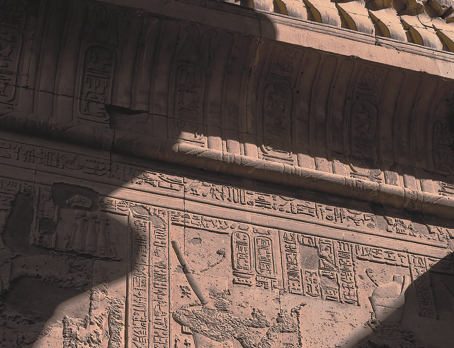Where time meets eternity in Egypt's Grand Museum


Beneath the unblinking gaze of the pyramids, where desert light has traced shadows for thousands of years, a new chapter of Egypt's story begins. Standing at the edge of antiquity and modernity, the Grand Egyptian Museum rises like a monument to memory — vast, gleaming, and serene.
For millennia, Egypt's treasures were scattered across temples, tombs and museums. Now, for the first time, their stories converge under one roof at the foot of the Giza Plateau, in what has become one of the most ambitious cultural projects in the world.
The museum's official opening on Nov 1, followed by its public debut on Nov 4, marked more than a ceremonial event. The date is profoundly symbolic — it fell exactly 103 years after archaeologist Howard Carter unearthed the resting place of a young pharaoh whose name would echo through time: Tutankhamun.
To celebrate, the skies over Luxor bloomed with color as dozens of hotair balloons drifted above the Nile Valley, each carrying the image of the museum — a symbol of national pride and a gesture linking the past and present, the earth and sky.
Renewed vision
GEM is more than a landmark of archaeology — it is a statement of renewal. Its opening comes as Egypt reimagines its place on the world's cultural map, positioning itself as a destination where world heritage can be experienced — immersive, dynamic, and evolving over centuries.
For decades, Egypt's tourism identity has been tied to the shimmer of the Red Sea — its coral reefs, sun-drenched beaches, and diving havens. Today, the nation seeks to show that its allure extends far beyond the water's edge. The new campaign, "Unmatched Diversity", invites travelers to look inland — to the pulse of Egypt's cultural heritage, Cairo's contemporary art scene, and the desert's spiritual silence. It is an invitation to experience Egypt as a land where ancient legacies and modern creativity meet.
New infrastructure, including the expansion of Sphinx International Airport, supports this broader vision, easing access to Giza's growing cultural corridor and connecting visitors from across the globe directly to the heart of Egypt's story.
Egyptian Minister of Tourism and Antiquities Sherif Fathy, speaking in an interview with Ahmed Salem on ON TV's Kalema Akheera, described the shift as both strategic and deeply cultural: "We recorded a 6 percent increase last year, and this year, we've entered the 20," he said. "We are no longer promoting separate products but rather Egypt's diversity as a whole — something that exists nowhere else."
Civilization unveiled
GEM stands as a symbol of Egypt's richness — unveiling the country's historic grandeur and depth. Occupying more than 300,000 square meters, GEM is the largest museum in the world devoted to a single civilization. More than 100,000 artifacts speak not only of power and divinity, but also of craftsmanship, continuity and the search for eternity.
Among them is the complete collection from Tutankhamun's tomb, displayed together for the first time since its discovery in 1922. At the heart of the collection lies the golden face that has captivated the world's imagination for a century — the 23-carat death mask, a symbol of both immortality and artistic perfection.
Nearby, the delicate furnishings of Queen Hetepheres, mother of Khufu, capture the grace of Egypt's earliest dynasties, their geometry echoing the order of the cosmos. In another hall, the Khufu's Solar Boat, an extraordinary wooden vessel crafted to sail the heavens, stands as a testament to ancient ingenuity and faith.
Walking through the galleries, one senses that the museum is a dialogue — between stone and light, kings and craftsmen, the mortal and the eternal. From the pre-dynastic artisans who carved the first alabaster vessels to the Greek and Roman influences that reshaped Egypt's art in later centuries, the exhibition traces the rhythm of a civilization that has reinvented itself across millennia yet never lost its soul.
Architecturally, GEM is also a bridge between worlds. Its translucent facade faces the pyramids, capturing the desert's shifting glow, while its vast atrium houses colossal statues, including the towering figure of Ramses II, who greets visitors as he once greeted the sun.
Mona El Shehawi, executive director at Moon Travel Group, highlighted the museum's role in fostering global cultural exchange: "The Chinese people are fond of Egyptian monuments and culture, so this will be a great opportunity to visit Egypt and know more about our culture and history."
Beyond its galleries, GEM houses children's and educational centers, temporary exhibition halls, a cinema, and conference facilities, alongside gardens, cafes and restaurants — all designed to merge culture and leisure in one immersive experience.
Visitors can explore select spaces, including the Hanging Obelisk Plaza, the Grand Hall, and open-air gardens. Beneath monumental columns stand the Victory Column of King Merenptah and twin statues of Ptolemaic rulers — silent witnesses to millennia of dynastic splendor.
The main exhibition halls, including the Grand Staircase and Tutankhamun Galleries, will open gradually, each revealing a new layer of Egypt's narrative. Together, these displays create a dialogue across time and geography, illustrating how ancient Egypt has influenced and remained pivotal in global heritage.
Shared heritage
Sherif Messiha, regional security advisor at the United Nations Department for Safety and Security, reflected on the deep ties between Egypt and China: "I can say that my Chinese friends are the children of the Yellow River — they are the heirs of the Nile. Our two peoples, separated by vast deserts and towering mountains, independently forged two of the world's most magnificent, enduring, and influential civilizations."
He added: "GEM is the perfect venue to appreciate this shared human spirit."
Through its collections, exhibitions, and programs, the museum positions Egypt not just as a custodian of history, but as a bridge between civilizations — a place where the story of humanity is told through art, ingenuity and enduring cultural dialogue.


Today's Top News
- China suspends part of control measures on dual-use items export to US
- Andy Palmer: West can learn from China's long-term planning
- Mainland spokesman reiterates stand on Taiwan
- Xi to attend opening ceremony of National Games, declare Games open
- Xi urges deepening reform, opening-up during Guangdong inspection tour
- China releases white paper on low-carbon development






























